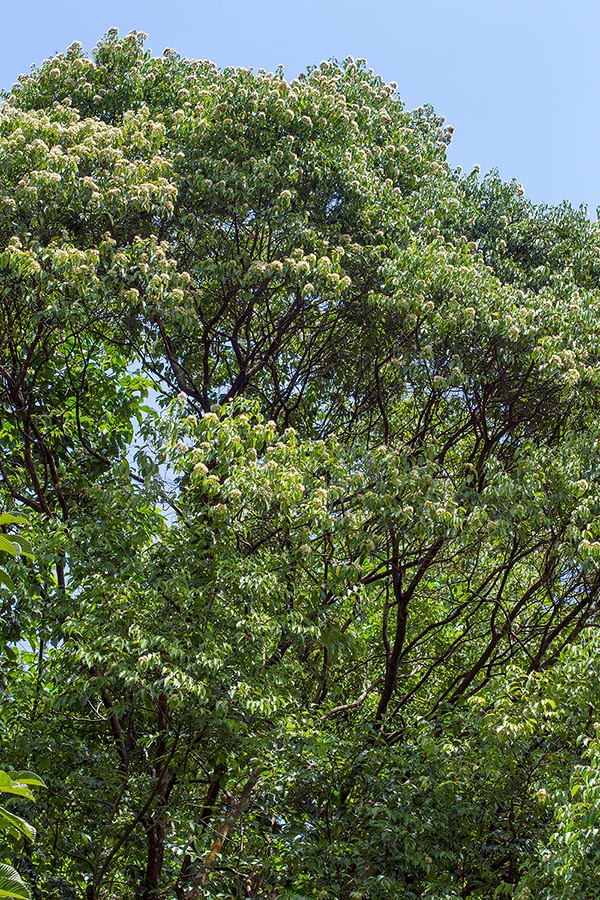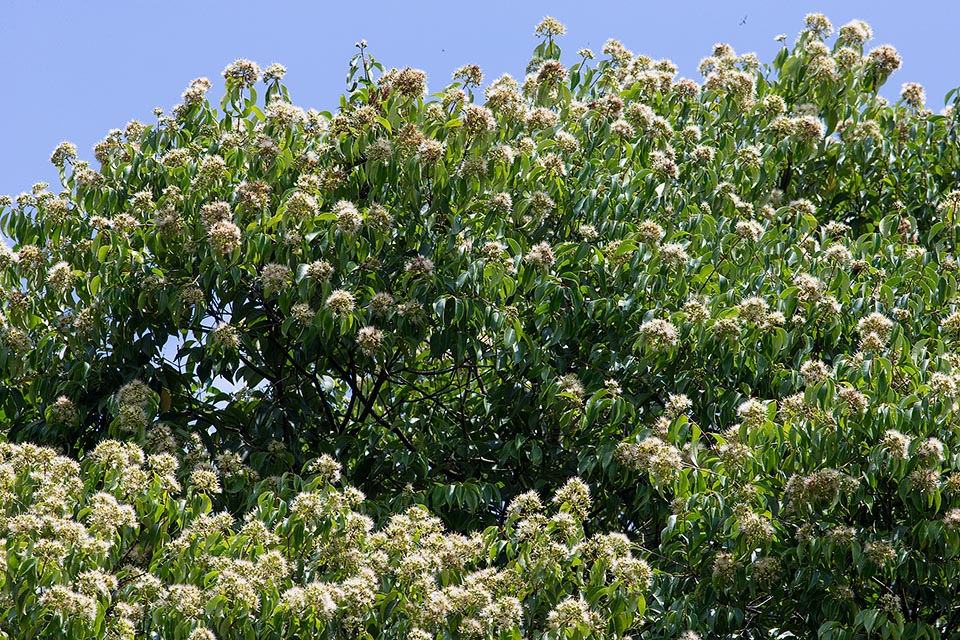Family : Myrtaceae

Text © Pietro Puccio

English translation by Mario Beltramini

In the often swampy forests of South-East Asia, the Syzygium lineatum reaches the height of 30 m © Giuseppe Mazza
The name of the genus is the combination of the Greek terms “σύν” (syn) = together and “ζύγον” (zygon) = yoke, with reference to the petals united in some species; the name of the species is the Latin adjective “lineatus, a, um” = provided with lines, with reference to the numerous secondary veins of the leaf.
Common names: common kelat (English); galam, obah (Borneo); pring, pring chan, pring phnom (Cambodia); kayu udang (Indonesia); gelam, ki sireum, nagasari (Java) kayu kelat, kelat puteh, sekujah (Malaysia); lagi-lagi, lubeg (Philippines) daeng song plucak, khi tai, phung kha (Thailand); trâm ba vỏ, trâm hang, trâm khế (Vietnam).
The Syzygium lineatum (DC.) Merr. & L.M.Perry (1938) is a shrub or evergreen tree up to 30 m tall in the old specimens in nature, but that usually maintains much lower, with dense foliage and erect trunk, of up to 50 cm of diameter, with greyish bark tending to flake off with the age, rich of tannins; in swampy or frequently flooded zones at times produces at the base stilt roots for supporting the stem. The leaves, on an about 1 cm long petiole, are opposite, simple, 6-12 cm long and 2,5-4,5 cm broad, with acuminate to caudate apex, rather coriaceous, with numerous secondary veins, parallel and spaced of 1-2 mm, more visible on the lower page.
The inflorescences are terminal or axillar erect cymes, 4-12 cm long, bearing several white or white-pinkish bisexual flowers, perfumed, rich of nectar, with obconical hypanthium (involucre that in some species surrounds the inferior or subinferior ovary), about 6 mm long, calyx with 4 semicircular lobes, 2 mm long and 3 mm broad, persistent in fruit, 4 ovate petals precociously deciduous, 3-4 mm long and broad, numerous white stamens 0,6-1 cm long and about 1 cm long style. The fruits are globose to ellipsoid berries, 1-1,4 cm long, and of 1 cm of diameter, initially green, then white and finally reddish when ripe, fleshy, edible, containing one seed only.
It reproduces by seed, that must be interred as soon as possible having a short lasting germinability, and by cutting and air layering.
Species diffused in nature and frequently cultivated in the origin areas, in parks and gardens and as road tree, due to its dense crown and the abundant perfumed blooming from December to June, and to a lesser extent, for the fruits. It requires full sun and adapts to different types of soil, even poor, sandy to heavy, and stands well the water stagnations and the marine aerosols.

Cultivated in tropics for the dense crown that shades roads and gardens, has perfumed inflorescences, rich of nectar, small edible fruits, good wood and medicinal virtues © Giuseppe Mazza
Synonyms: Myrtus lineata Blume (1826); Jambosa lineata DC. (1828); Syzygium longiflorum C.Presl (1845); Clavimyrtus latifolia Blume (1850); Clavimyrtus lineata (DC.) Blume (1850); Clavimyrtus symphytocarpa Blume (1850); Jambosa latifolia (Blume) Miq. (1855); Jambosa rubricaule Miq. (1855); Jambosa symphytocarpa (Blume) Korth. ex Miq. (1855); Syzygium zippelianum Miq. (1855); Jambosa teysmannii Miq. (1861); Eugenia lineata (DC.) Duthie (1878); Eugenia rubricaulis (Miq.) Duthie (1878); Eugenia longiflora (C.Presl) Fern.-Vill. (1880); Eugenia teysmannii (Miq.) Koord. & Valeton (1900); Eugenia zippeliana (Miq.) Koord. & Valeton (1900); Eugenia marivelesensis Merr. (1906); Eugenia miquelii Elmer (1912); Eugenia longicalyx Ridl. (1930); Syzygium longicalyx (Ridl.) Masam. (1942); Syzygium teysmannii (Miq.) Masam. (1942).
→ To appreciate the biodiversity within MYRTACEAE family please click here.
